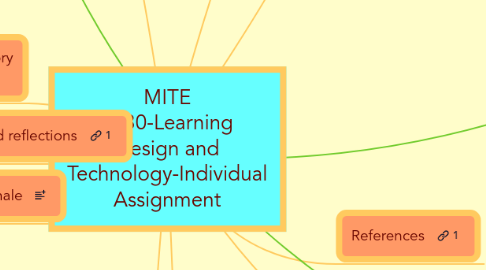
1. Definition of instructional design
1.1. It focuses on the process and needs of the learner
1.2. It refers to the practice to maximise the effectiveness of the learning experience
2. Instructional design theory and learning objects
2.1. Wiley's Preliminary Taxonomy of Learning Objects
2.1.1. Wiley's Conclusion
3. ADDIE Model-Group work for this module-Stages
3.1. Analysis
3.1.1. Instructional goals and objectives
3.2. Design
3.2.1. Learning objectives
3.2.2. Assessment instruments
3.2.3. Content
3.2.4. Subject matter analysis
3.2.5. Lesson planning
3.2.6. Media selection
3.3. Development
3.3.1. Storyboards
3.3.2. Prototypes
3.4. Implementation
3.5. Evaluation
3.5.1. Formative assessment
3.5.2. Summative assessment
4. Conclusion and reflections
5. Rationale
6. Mobile learning devices
6.1. Devices other than phone
6.2. Wide range of applications
6.3. Limitations due to their size solved by the use of tablets
6.4. Affordances
6.4.1. Text, e-books
6.4.2. Multimedia
6.4.3. Internet connection and access to Web 2.0 tools
6.4.4. Connectivity
6.4.5. Analytical and capture tools
6.4.6. Representational tools
7. Key learning theories applied to instructional design
7.1. Behaviourism
7.1.1. Impact on instructional design not until the 1960s-Emphasis on external behaviour
7.1.2. States learning objectives in specified, quantifiable, terminal behaviours summed up in ABCD-Behavioural Objectives Movement
7.1.2.1. A-Audience-the student
7.1.2.2. B-Behaviour-Answer Correctly
7.1.2.3. C-Condition
7.1.2.4. D-Degree of success
7.1.3. Taxonomic Analysis of Learning Behaviours
7.1.3.1. Bloom's Taxonomy of Learning, 1956
7.1.3.1.1. Knowledge
7.1.3.1.2. Comprehension
7.1.3.1.3. Application
7.1.3.1.4. Analysis
7.1.3.1.5. Synthesis
7.1.3.1.6. Evaluation
7.1.3.2. Gagne's taxonomy
7.1.3.2.1. Verbal information
7.1.3.2.2. Intellectual skill
7.1.3.2.3. Cognitive strategy
7.1.3.2.4. Attitude
7.1.3.2.5. Motor skill
7.1.3.3. Gagne's Nine Events of Instruction
7.1.3.3.1. Gain attention
7.1.3.3.2. Inform learner
7.1.3.3.3. Stimulate recall of previous learning
7.1.3.3.4. Present stimulus material
7.1.3.3.5. Provide learner guidance
7.1.3.3.6. Elicit performance
7.1.3.3.7. Provide feedback
7.1.3.3.8. Assess performance
7.1.3.3.9. Enhance retention transfer
7.1.4. Mastery learning developed by Morrison in the 1930s
7.1.4.1. Lower level of learning as demonstrated by Bloom in his taxonomy
7.1.4.2. It assumes all students can master the materials presented in the lesson
7.2. Constructivism-More open-ended learning experience
7.2.1. Merrill's First Principles of Instruction-Effective learning environments are problem-based
7.2.1.1. Problem
7.2.1.1.1. Activation
7.2.1.1.2. Demonstration of skills
7.2.1.1.3. Aplication
7.2.1.1.4. Integration
7.2.2. Jerold Kemp's instructional design model
7.2.2.1. Identify instructional problems and goals for designing
7.2.2.2. Examine learners' characteristics
7.2.2.3. Identify subject content
7.2.2.4. State instructional objectives for the learner
7.2.2.5. Sequence content
7.2.2.6. Design instructional strategies
7.2.2.7. Plan the instructional message and its delivery
7.2.2.8. Develop assessment strategies
7.2.2.9. Select resources to support learning
7.2.3. Bruner's constructivist theory
7.2.3.1. learning as an active process
7.2.3.2. Learners go beyond instruction to discover the key principles by themselves
8. Cognitivism-Based on schema and mental operations
8.1. Impact on instructional design in the late 70s- It focuses on the internal process of the mind and their impact on learning
8.1.1. Advanced organisers
8.1.2. Mnemonic devices
8.1.3. Computer based instruction
8.2. Vygotsky's theory of social cognitve development
8.2.1. Social interaction as a key element in the development of cognition
8.3. Cognitive theory on multimedia learning and design.
8.3.1. Multiple representation principle
8.3.2. Contiguity principle
8.3.3. Split attention principle
8.3.4. Individual differences principle
8.3.5. Coherence principle
9. Web 2.0 Based Learning Technology
9.1. Metaphor for a spectrum of emerging novel internet applications
9.2. Paradigm shift on the understanding on how the internet works. Constructivist approach, focused on the learner and collaboration
9.3. Application, uses and examples
9.3.1. Read-Write Web
9.3.1.1. Blogs
9.3.1.2. Wikis
9.3.2. Subscribing for information
9.3.2.1. RSS
9.3.3. Social spaces and network
9.3.3.1. My Space
9.3.3.2. Facebook
9.3.3.3. You Tube
9.3.4. Internet as a platform for collaboration
9.3.4.1. Google Applications
9.3.5. Social bookmarking
9.3.5.1. RISAL
9.3.5.2. Diigo
9.3.5.3. Delicious
9.4. Educational and work impact-Reflection
9.4.1. Authentic learning
9.4.2. Collaboration
9.4.3. It enables learners and educators around the world to work together breaking space barriers
9.4.4. Promotes innovation and higher order thinking skills
9.4.5. Promotion of internationalism and understanding of global issues
